 W
WThe 1-yen coin is the smallest denomination of the Japanese yen currency. The first Japanese one-yen coins were made of both silver and gold in the early 1870s. Issues facing the Japanese government at the time included wanting to adopt the gold standard, and competing against the Mexican dollar for use in foreign trade. The decision was made to use silver one yen coins exclusively outside of Japan for trade, while gold coins were minted and used in mainland Japan. Gold and silver coins were eventually allowed to co-circulate in mainland Japan from 1878 to 1897 when they were demonetized. Millions of former one yen silver coins were countermarked by the Japanese government for use outside of the mainland. Silver one yen coins continued to be minted until 1914 for backing up currency.
 W
WThe 2 yen coin (二圓金貨) was a short lived denomination of Japanese yen. During the first year of mintage in 1870, hundreds of thousands of these new coins were struck. These figures dropped off sharply as the Japanese government looked towards silver as a trading commodity. The supply of gold bullion had also dwindled causing the demand for these coins to outpace the supply available. The public hoarded two yen coins along with other denominations of gold causing them not to circulate during the mid 1870s. Japan eventually obtained a supply of gold bullion towards the end of the century, but this came too late for the two yen coin which was last minted in 1892. Almost one hundred years later the two yen coin was officially demonetized. While not in circulation any more, these coins are bought and sold by numismatics for academic study, and by those with a hobby.
 W
WThe 5 yen coin is one denomination of Japanese yen. The current design was first minted in 1959 using Japanese characters known as the "new script", and were also minted from 1948 to 1958 using "old-script" Japanese characters. Five-yen coins date to 1870. The modern-day coin was first produced in 1948 with a differently styled inscription. This was changed in 1959 and the design has remained unchanged since.
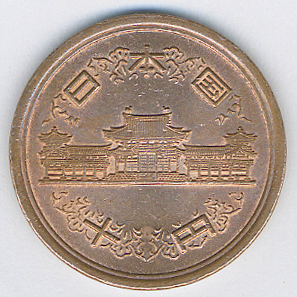 W
WThe 10 yen coin is one denomination of the Japanese yen.
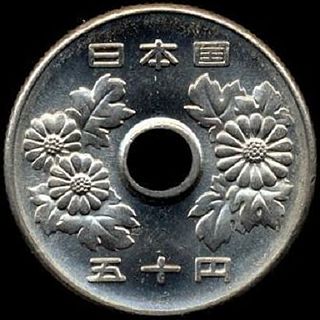 W
WThe 50 yen coin is a denomination of Japanese yen. These coins were first minted in 1955, and concurrently circulated alongside a banknote denomination of the same amount. 50 yen notes were eventually pulled from circulation shortly before the center of the 50 yen coin was holed. The first yen coins were made of pure nickel and slightly larger than the ones used today. Changes to the 50 yen coin were made in response to events surrounding the 100 yen coin. The public wanted a different looking 50 yen coin while the mint wanted to stay consistent with the material used to make the coins. The current design was first minted in 1967 using Cupronickel rather than pure nickel. The 50 yen coin continues to be minted for commerce, and is a collectible among hobbyists.
 W
WThe 50 yen note (五十円紙幣) was a denomination of Japanese yen that was issued from 1872 to 1958 (non-consecutively) in paper form. The first two issues for this denomination are rare for various reasons, including the latter of the two not being released for circulation. The final issue was short-lived as it was only issued from 1951 to 1958. Eventually a "stop payment" order was given causing the old 50 yen bills to be pulled from circulation in favor of the 50 yen coin. While "B series" notes continue to retain their legal tender status, they are now worth more as collectables.
 W
WThe 100 yen coin is a denomination of Japanese yen. The current design was first minted in silver in 1959 and saw a change of metal in 1967. It is the second-highest denomination coin in Japan after the 500 yen coin. The current 100 yen coin is one of two denominations which depict the emperor's rule date in Arabic numerals rather than Kanji. These numbers go from "昭和42" Shōwa, 42nd year of reign (1967) to "令和2" Reiwa, 2nd year of reign (2020).
 W
WThe 500 yen coin is the largest denomination of Japanese yen issued for circulation. These coins were first struck in 1982 as the vending machine industry needed a higher valued coin for use in their machines. The denomination had previously been issued as paper currency which co-circulated with the new coins until 1994. Originally the 500 yen coin was made up of cupronickel, but was later changed to nickel brass, and then to bi-metallic to deter counterfeiting. This illegal practice has been a constant issue since the coin was first released due to its high purchase value. With a history spanning 3 imperial eras, 500 yen coins are also collectibles.
 W
WThe ¥1,000 note is currently the lowest value yen banknote and has been used since 1945, excluding a brief period between 1946 and 1950 during the Allied occupation of Japan.
 W
WThe ¥2,000 note is a denomination of Japanese yen, that was first issued on July 19, 2000 to commemorate the 26th G8 Summit and the millennium. The banknote is notable for not being a commemorative banknote under Japanese law, and circulates as a regular issue. It is also the only currency using a number 2 denomination.
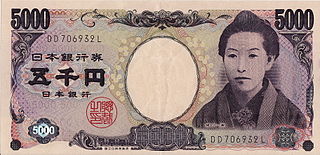 W
WThe ¥5,000 note was first introduced in Japan in 1957 to the third series of banknote releases. The latest release is Series E (2004).
 W
WThe ¥10,000 note is the largest banknote denomination of the Japanese yen.
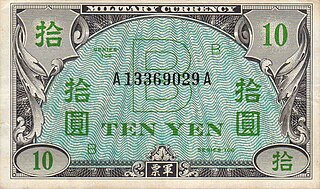 W
WB yen was a colloquial term used to refer to a form of military scrip used in post-war US-Occupied Okinawa from April 15, 1946, to September 1958. Officially, it was called B type military scrip .
 W
WThe Bank of Japan is the central bank of Japan. The bank is often called Nichigin (日銀) for short. It has its headquarters in Chūō, Tokyo.
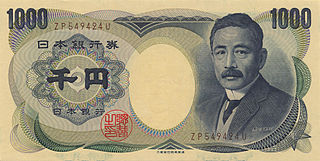 W
WThe banknotes of the Japanese yen are part of the physical form of Japan's currency. Modern banknotes were first released by the Bank of Japan in 1885, three years after the Japanese government established a centralized bank. Throughout their history, the denominations have ranged from 0.05 yen to 10,000 yen.
 W
WCountermarked yen refers to Japanese trade dollars and 1 yen coins that are stamped 銀 , literally meaning "silver". The countermark was added by the Japanese government in 1897 to these coins dated up to that point. This came at a time when Japan went onto the gold standard prompting the government to confine these two denominations for use outside the mainland.
 W
WThe Currency Museum of the Bank of Japan , formally known as the Currency Museum, Institute for Monetary and Economic Studies, Bank of Japan is a museum about Japanese currency located in front of the Bank of Japan building in Chūō, Tokyo.
 W
WJapanese invasion money, officially known as Southern Development Bank Notes, was currency issued by the Japanese Military Authority, as a replacement for local currency after the conquest of colonies and other states in World War II. In February 1942 in Japan, laws were passed establishing the Wartime Finance Bank and the Southern Development Bank. Both institutions issued bonds to raise funds. The former loaned money primarily to military industries, but also to a wide range of other ventures, including hydroelectric generators, electric power companies, shipbuilding and petroleum. The latter provided financial services in areas occupied by the Japanese military, and Southern Development Bank notes were in fact used as de facto military scrip. In December 1942, the outstanding balance of Southern Development Bank notes stood at more than 470 million; in March 1945, more than 13 billion.
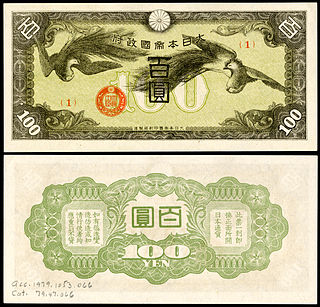 W
WJapanese military currency was money issued to the soldiers of the Imperial Japanese Armed Forces as a salary. The military yen reached its peak during the Pacific War period, when the Japanese government excessively issued it to all of its occupied territories. In Hong Kong, the military yen was forced upon the local population as the sole official currency of the territory. Since the military yen was not backed by gold, and did not have a specific place of issuance, the military yen could not be exchanged for the Japanese yen. Forcing local populations to use the military yen officially was one of the ways the Japanese government could dominate the local economies.
 W
WThe mon was the currency of Japan from the Muromachi period in 1336 until the early Meiji period in 1870. It co-circulated with the new sen until 1891. The Kanji for mon is 文 and the character for currency was widely used in the Chinese-character cultural sphere, e.g. Chinese wen, Korean mun, Vietnamese văn. Throughout Japanese history, there were many different styles of currency of many shapes, styles, designs, sizes and materials, including gold, silver, bronze, etc. Coins denominated in mon were cast in copper or iron and circulated alongside silver and gold ingots denominated in shu, bu and ryō, with 4000 mon = 16 shu = 4 bu = 1 ryo. In 1869, due to depreciation against gold, the new fixing officially was set for 1 ryo/yen = equal to 10.000 mon. The yen started to replace the old duodecimal denominations in 1870: in 3rd quarter of 1870, the first new coins appeared, namely 5, 10, 50 sen silver and 2, 5, 10, 20 Yen. Smaller sen coins did not appear before spring, 1873. So the mon coins remained a necessity for ordinary peoples commodities and were allowed to circulate until 31st December, 1891. From January 1, 1954 onward, the mon became invalid: postwar inflation had removed sen, mon etc. denominations smaller than 1 Yen. Due to the missing small coinage, the Japanese posts e.g. issued their first stamps in mon and fixed postal rates in mon until April, 1872.
 W
WJapanese numismatic charms, also known as Japanese amulets, Japanese talismans, or simply Japanese charms, refer to a family of cash coin-like and other numismatic inspired types of charms that like the Korean and Vietnamese variants are derived from Chinese numismatic charms, but have evolved around the customs of the Japanese culture. Although most of these charms resemble Japanese cash coins and the amulet coins of China, they contain their own categories unique to Japan. In the case of these coins, "charm" in this context is a catchall term for coin-shaped items which were not official money. However, these numismatic objects were not all necessarily considered "magical" or "lucky", as some of these Chinese numismatic charms can be used as "mnemonic coins".
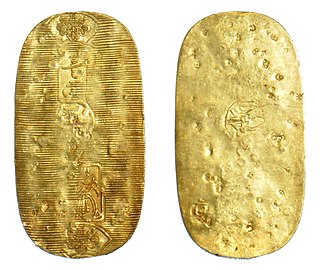 W
WThe ryō was a gold currency unit in the shakkanhō system in pre-Meiji Japan. It was eventually replaced with a system based on the yen.
 W
WWadōkaichin (和同開珎), also romanized as Wadō-kaichin or called Wadō-kaihō, is the oldest official Japanese coinage, first minted on 29 August 708 on order of Empress Genmei.
 W
WThe yen is the official currency of Japan. It is the third most traded currency in the foreign exchange market, after the United States dollar and the Euro. It is also widely used as a third reserve currency after the United States dollar and the Euro.
 W
WThe Kan'ei Tsūhō was a Japanese mon coin in use from 1626 until 1868 during the Edo period. In 1636, the Kan'ei Tsūhō coin was introduced by the Tokugawa shogunate to standardise and maintain a sufficient supply of copper coinage, and it was the first government-minted copper coin in 700 years. The government adopted the coin after its successful introduction in the Mito domain ten years prior in 1626, the third year of the Kan'ei era. These coins would become the daily currency of the common people and would be used for small payments.
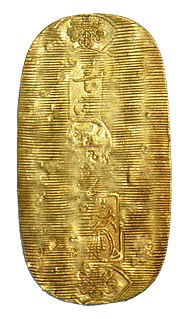 W
WThe koban (小判) was a Japanese oval gold coin in Edo period feudal Japan, equal to one ryō, another early Japanese monetary unit. It was a central part of Tokugawa coinage.
 W
WCash coins were introduced to Japan in the century inspired by the Chinese Kaigen Tsūhō (開元通寳) cash coins from the Tang dynasty. Chinese cash coins also circulated in other countries and inspired similar currencies such as the Korean mun, Ryukyuan mon, Vietnamese văn, while they also circulated as far south as Indonesia. Because these currencies were so similar cash coins around the Far East were interchangeable and Japanese cash coins circulated in other countries while foreign cash coins also circulated in Japan.
 W
WThe following is a list of pattern coins from the yen based currency system started under the Meiji Restoration. The first patterns of the yen based system were made from 1869 to 1870 as presentation pieces to the Emperor. The new currency system was eventually adopted by the Meiji government in an Act signed on June 27, 1871. Pattern coins are almost never released into circulation as they are made for evaluation purposes only. Once a pattern is approved by government officials, it then goes to the minting process. Most of the patterns listed below are very rare, and sell for considerable amounts at auctions. The market value and rarity of any given coin is dependent on supply and demand.
 W
WThe Japan Mint is an Independent Administrative Institution of the Japanese government, responsible for producing and circulating the coins of Japan. The agency has its head office in Osaka with branches in Tokyo and Hiroshima. The Japan Mint does not produce paper money; that responsibility belongs to the National Printing Bureau.
 W
WMother coins, alternatively known as seed coins or matrix coins, were coins used during the early stages of the casting process to produce Chinese, Japanese, Korean, Ryukyuan, and Vietnamese cash coins. As cash coins were produced using sand casting mother coins were first produced to form the basis for all subsequent cash coins to be released into circulation. Under the Han dynasty in China mints started producing cash coins using bronze master moulds to solve inconsistencies in circulating coins, this only worked partially and by the sixth century mother coins were introduced to solve these inconsistencies almost completely. The Japanese adopted the usage of mother coins in the 600s and they were used to manufacture cast Japanese coins until the Meiji period. The mother coin was initially prepared by engraving a pattern with the legend of the cash coin which had to be manufactured. In the manufacturing process mother coins were used to impress the design in moulds which were made from easily worked metals such as tin and these moulds were then placed in a rectangular frame made from pear wood filled with fine wet sand, possibly mixed with clay, and enhanced with either charcoal or coal dust to allow for the molten metal to smoothly flow through, this frame would act as a layer that separates the two parts of the coin moulds. The mother coin was recovered by the people who cast the coins and was placed on top of the second frame and the aforementioned process was repeated until fifteen layers of moulds had formed based on this single mother coin. After cooling down a "coin tree" (錢樹) or long metallic stick with the freshly minted cash coins attached in the shape of "branches" would be extracted from the mould and these coins could be broken off and if necessary had their square holes chiseled clean, after this the coins were placed on a long metal rod to simultaneously remove the rough edges for hundreds of coins and then these cash coins could be strung together and enter circulation.
 W
WNagasaki trade coins (長崎貿易銭), also known as Nagasaki export coins refer to Japanese mon coins specifically cast for export by the Tokugawa government between 1659 and 1685 during the Sakoku era. Though the inscriptions on the coins often match Chinese coins from the Song dynasty they’re often cast with different typefaces such as the fact that the Genpō Tsūhō (元豊通寳) produced at Nagasaki was in Clerical script while the Song dynasty’s versions were in Seal script and Running script. Due to the success of these coins they’re often still found in modern day Vietnam and Java, and were copied by contemporary Vietnamese mints as they had become the de facto standard coinage in Vietnam as native production had declined in the 17th century. As the export of gold and silver was banned by the Qing dynasty Japanese merchants were most likely to go to Hanoi and Hội An to gain access to Chinese products causing these coins to start circulating en masse on the Vietnamese market. A special “5 elements” series of Nagasaki trade coins were also cast for export to Taiwan.
 W
WNational Printing Bureau (NPB) is a Japanese governmental agency in charge of the production of Japanese paper money, Japanese yen. It also produces various other products, such as postage stamps and the official governmental gazette.
 W
WAn Ōban (大判) was a monetary ovoid gold plate, and the largest denomination of Tokugawa coinage. Tokugawa coinage worked according to a triple monetary standard, using gold, silver and bronze coins, each with their own denominations.
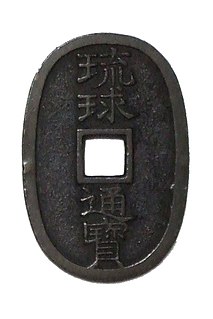 W
WThe Ryukyuan mon was the currency of the Ryukyu Kingdom from 1454 to 1879, when the kingdom was annexed by the Empire of Japan and the currency was replaced by the Japanese yen. The Chinese character for mon is 文, which was widely used in the Chinese-character cultural sphere, e.g. Chinese wén, Vietnamese văn, and Korean mun. The Ryukyuans produced their own coins until the 15th century, but became dependent on Chinese coins until the 19th century when they briefly minted their own coins again. From 1862 the minting was outsourced to Kagoshima City, Satsuma Domain and were based on the Japanese mon. All of the Kagoshima-minted coins bear the phrase "Ryūkyū Tsūhō" ; this phrase was written in Seal script on the half shu coin. Despite the annexation of the Ryukyu Kingdom in 1879, these coins continued to circulate within Okinawa Prefecture well into the 1880s as the Ryukyuans were initially unwilling to use Japanese yen coins.
 W
WDuring the Edo period, feudal domains of Japan issued scrip called hansatsu (藩札) for use within the domain. This paper currency supplemented the coinage of the Tokugawa shogunate. Most scrip carried a face value in silver coinage, but gold and copper scrip also circulated. In addition, some scrip was marked for exchange in kind for a commodity such as rice. In addition to those issued by the domains, forms of paper money were also issued by rice brokers in Osaka and Edo. Originally used only as a representation of amounts of rice owned by the scrip-holder and held in the Osaka or Edo merchants' storehouse, these scrips quickly came to be used as currency.
 W
WA string of cash coins refers to a historical Chinese, Japanese, Korean, Ryukyuan, and Vietnamese currency unit that was used as a superunit of the Chinese cash, Japanese mon, Korean mun, Ryukyuan mon, and Vietnamese văn currencies. The square hole in the middle of cash coins served to allow for them to be strung together in strings, the term would later also be used on banknotes and served there as a superunit of wén (文).
 W
WThe Tenpō Tsūhō was an Edo period coin with a face value of 100 mon, originally cast in the 6th year of the Tenpō era (1830). The obverse of the coin reads "Tenpō" a reference to the era this coin was designed in, and "Tsūhō" which means "circulating treasure" or currency. The Kaō is that of Gotō San'emon, a member of the Kinza mint's Gotō family, descendants of Gotō Shozaburo Mitsutsugu, a metalworker and engraver from Kyoto appointed by shōgun Tokugawa Ieyasu in 1600 o oversee the Edo mint of his shogunate and oversee its coinage. All mother coins were produced in Edo before they were sent to other mints where they would place the individual mint's mark on the edge of the coin. The coin circulated for 40 years, and stopped being produced during the Meiji Restoration after the introduction of the Japanese yen. Today these coins are now sold as "lucky charms" as well as being collected by numismatists.
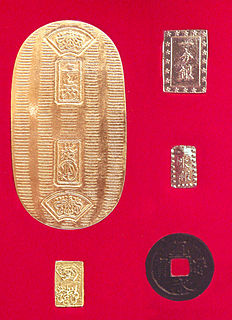 W
WTokugawa coinage was a unitary and independent metallic monetary system established by shōgun Tokugawa Ieyasu in 1601 in Japan, and which lasted throughout the Tokugawa period until its end in 1867.